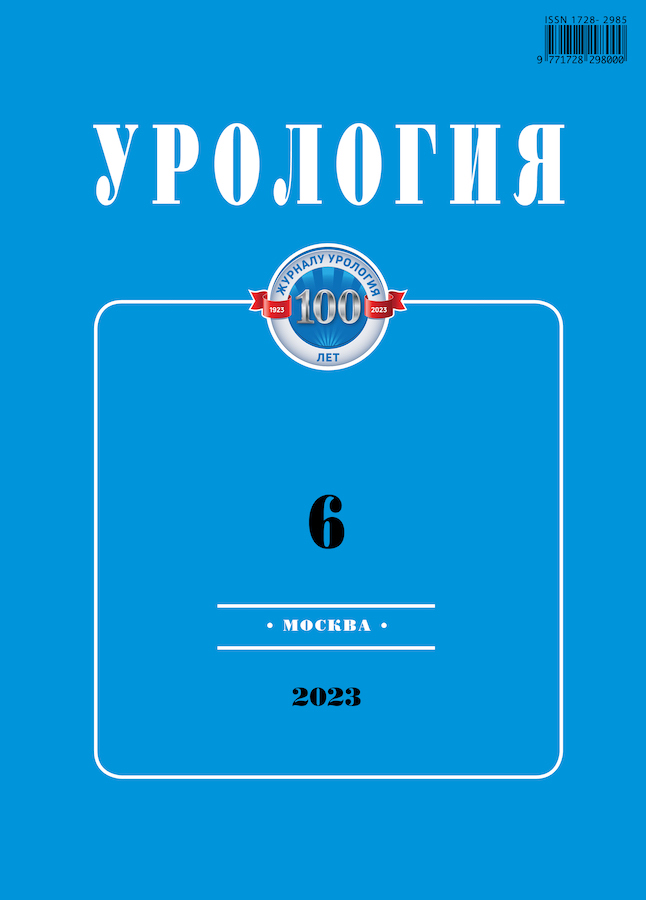Minimizing the number of trocars during laparoscopic partial nephrectomy. Surgical technique
- Authors: Kurbanov А.А.1, Chernov Y.N.1, Chinenov D.V.1, Tsukkiev Z.K.1, Votyakov А.Y.1, Lerner Y.V.1, Sutugin K.E.2, Shpot E.V.1
-
Affiliations:
- Institute for Urology and Human Reproductive Health of FGAOU I.M. Sechenov First Moscow State Medical University
- Obninsk Institute for Nuclear Power Engineering
- Issue: No 6 (2023)
- Pages: 102-107
- Section: Oncourology
- Published: 27.12.2023
- URL: https://journals.eco-vector.com/1728-2985/article/view/626206
- DOI: https://doi.org/10.18565/urology.2023.6.102-107
- ID: 626206
Cite item
Abstract
Introduction. During last 20 years in urology there has been a number of significant advancements, which were due to the introduction into practice and improvement of minimally invasive techniques. Development of laparoscopic surgery allowed to actively introduce these procedures in various kidney disorders, including renal tumors. Laparoscopic partial nephrectomy is also undergoing changes in order to improve the technique. Standard technique requires four or more trocars, where fourth (additional) trocar is put for the assistant. However, there is an opinion that in most cases it is possible to perform partial nephrectomy without an assistant trocar, while maintaining the safety and efficiency of the procedure and improving some perioperative outcomes. The aim of our study was to compare the safety and efficiency of the three-trocar and four-trocar techniques during transperitoneal partial nephrectomy. This article also presents the technical features of laparoscopic partial nephrectomy.
Materials and methods. Between 2021 and 2023, a total of 200 patients were included in the study comparing three- and four-trocar partial nephrectomy.
Results. There was no difference in the rate of achieving renal trifecta between the two groups. In the three-trocar group, 94 cases of renal trifecta were found, while in the four-trocar group, there were 95 patients with renal trifecta.
Conclusions. The three-trocar technique is not inferior in safety and efficiency to the standard four-trocar technique. The main advantages of the three-trocar technique are less pain, cost and post-operative scarring.
Full Text
About the authors
А. А. Kurbanov
Institute for Urology and Human Reproductive Health of FGAOU I.M. Sechenov First Moscow State Medical University
Email: asadulla10@mail.ru
Ph.D., student
Russian Federation, MoscowY. N. Chernov
Institute for Urology and Human Reproductive Health of FGAOU I.M. Sechenov First Moscow State Medical University
Email: yarik.chernov@mail.ru
Ph.D., urologist
Russian Federation, MoscowD. V. Chinenov
Institute for Urology and Human Reproductive Health of FGAOU I.M. Sechenov First Moscow State Medical University
Email: chinenovdv@rambler.ru
Ph.D., associate professor
Russian Federation, MoscowZ. K. Tsukkiev
Institute for Urology and Human Reproductive Health of FGAOU I.M. Sechenov First Moscow State Medical University
Email: zaurtsukkiev@mail.ru
Ph.D., student
Russian Federation, MoscowА. Y. Votyakov
Institute for Urology and Human Reproductive Health of FGAOU I.M. Sechenov First Moscow State Medical University
Email: votyakov.a.yu@gmail.com
urologist
Russian Federation, MoscowY. V. Lerner
Institute for Urology and Human Reproductive Health of FGAOU I.M. Sechenov First Moscow State Medical University
Email: julijalerner@inbox.ru
Ph.D., assistant at the Department of Pathology named after A.I. Strukov
Russian Federation, MoscowK. E. Sutugin
Obninsk Institute for Nuclear Power Engineering
Email: sutugink@mail.ru
student
Russian Federation, ObninskE. V. Shpot
Institute for Urology and Human Reproductive Health of FGAOU I.M. Sechenov First Moscow State Medical University
Author for correspondence.
Email: shpot@inbox.ru
Ph.D., MD, professor
Russian Federation, MoscowReferences
- Axel E.M., Matveev V.В. Statistics of malignant tumors of urinary and male urogenital organs in Russia and the countries of the former USSR. Cancer Urology. 2019;15(2):15–24.
- Clayman R.V., Kavoussi L.R., Soper N.J., Dierks S.M., Meretyk S., Darcy M.D. Laparoscopic Nephrectomy: Initial Case Report. The Journal of Urology. 2017;197(2):S182–S186.
- Winfield H.N., Donovan J.F., Godet A.S. et al. Laparoscopic partial nephrectomy: initial case report for benign disease. J. Endourol. 1993;7:521–526.
- Gill I.S., Delworth M.G., Munch L.C. Laparoscopic retroperitoneal partial nephrectomy. J Urol. 1994;152:1539–1542.
- Miura R.K., Junqueira C.E., Tavares L., Maroclo R.R., Mattos Rde M., Damiao R. Transperitoneal laparoscopic nephrectomy in children: surgical technique with 3 trocars. Int Braz J Urol. 2002;28(4):346–348.
- Desgrandchamps F., Gossot D., Jabbour M.E., Meria P., Teillac P., Le Duc A. A 3 trocar technique for transperitoneal laparoscopic nephrectomy. J Urol. 1999;161(5):1530–1532.
- Allaf M.E., Bhayani S.B., Rogers C. et al. Laparoscopic partial nephrectomy: evaluation of long-term oncological outcome. J Urol. 2004;172(3):871–873.
- Gill I.S., Kavoussi L.R., Lane B.R. et al. Comparison of 1,800 laparoscopic and open partial nephrectomies for single renal tumors. J Urol. 2007;178(1):41–46.
- A.C. de Beaux, East B. Thoughts on Trocar Site Hernia Prevention. A Narrative Review. Journal of Abdominal Wall Surgery. 2022;1. doi: 10.3389/jaws.2022.11034.
- Nofal M.N., Yousef A.J., Hamdan F.F., Oudat A.H. Characteristics of Trocar Site Hernia after Laparoscopic Cholecystectomy. Sci Rep. 2020;10(1):2868. doi: 10.1038/s41598-020-59721-w.
- Ciscar A., Badia J.M., Novell F., Bolívar S., Mans E. Incidence and risk factors for trocar-site incisional hernia detected by clinical and ultrasound examination: a prospective observational study. BMC Surg. 2020;20(1):330. doi: 10.1186/s12893-020-01000-6.
- Raakow J., Klein D., Barutcu A.G., Biebl M., Pratschke J., Raakow R. Single-port versus multiport laparoscopic surgery comparing long-term patient satisfaction and cosmetic outcome. Surg Endosc. 2020;34(12):5533–5539. doi: 10.1007/s00464-019-07351-3.
- Ozbasli E., Takmaz O., Albayrak N., Gungor M. Cosmetic Outcome of Robotic Surgery Compared to Laparoscopic Surgery for Benign Gynecologic Disease. JSLS : Journal of the Society of Laparoscopic & Robotic Surgeons. 2022;26(2):e2021.00081. doi: 10.4293/JSLS.2021.00081.
- Trichak S. Three-port vs standard four-port laparoscopic cholecystectomy. Surg Endosc. 2003;17(9):1434–1436.
Supplementary files











